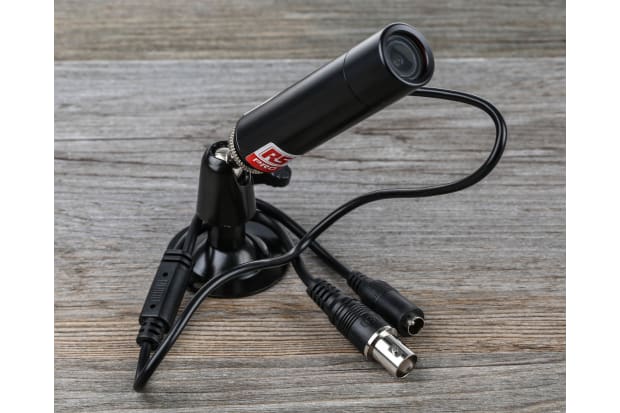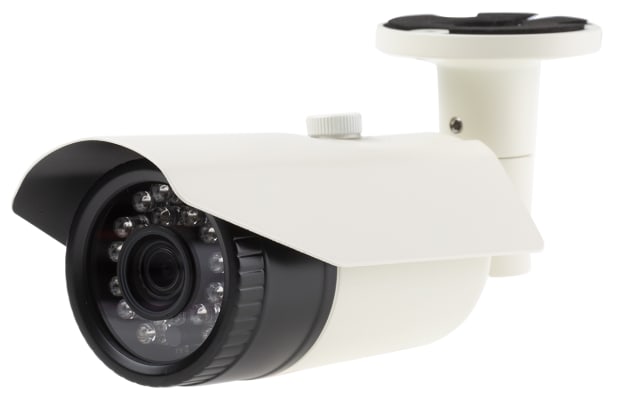- Published 28 Jun 2023
- Last Modified 29 Aug 2023
- 8 min
What is CCTV?
Surveillance cameras offer insight into what is happening in public spaces, on company premises, or on your own property. Provide more security and make burglary, theft, and vandalism more difficult whilst protecting employees.

Surveillance cameras provide additional protection in many areas where security is key, in public and commercial premises and at home. These inconspicuous devices capture and record what happens in monitored areas. They thus help detect criminal activities, prove events, and identify perpetrators. Often the mere presence of security cameras is enough to deter and prevent criminal activity. In industrial environments, they can also help monitor dangerous areas to better protect employees and take the right safety measures faster if necessary.
Video surveillance has become indispensable in many areas of public life. It is an integral part of security systems for monitoring locations including:
- Car parks and fuel stations
- Shops and commercial premises
- Airports, railway stations, and public transport
- Warehouses
How to Install CCTV

How to Install CCTV Camera
Learning how to install a CCTV camera step by step is typically straightforward. To install your camera, you must first connect it to a power supply. LED lights usually indicate it is operational. Next, you can connect the camera to your network router. You can also use this to link other devices you want to add to your camera system. Even if you later want to operate the camera via WLAN, initial installation via a network cable is recommended.
To manage your camera, you need its IP address. You can find this in the list of connected devices on your network router. Entering the IP address on the command line of your web browser will take you to your network camera's user interface. It is advisable to save this link as a favourite. You can find the login password in the user manual or at the bottom of the camera. Many manufacturers also supply software and smartphone apps to make managing your camera even easier.
How Much are CCTV Cameras?
The cost of CCTV cameras varies greatly depending on their features. Basic home security cameras can be purchased fairly cheaply. However, more advanced models designed for businesses, offering features like high-definition, night vision, and motion detection, can cost much more.
How Much is CCTV to Install?
The cost of installing a CCTV system depends on several factors such as the number of cameras and accessories, the type of cameras (wired or wireless), and the complexity of the installation. Professional installation is ideal for larger or more complex CCTV systems for businesses.
How Does CCTV Work?
Installing a CCTV system today is quite easy. A WLAN surveillance camera that connects to a router is sufficient for this. Video recordings can be saved on a hard drive, recorded with a digital video recorder, and viewed live on a computer or smartphone.
In businesses, CCTV systems can not only uncover criminal activities, but approved video surveillance systems can also minimise liability risks and help to reduce insurance rates. Large installations with multiple surveillance cameras are often used for this. Additional mirrors and pivoting cameras help to cover difficult-to-see areas. Images are sent to a storage and processing unit wirelessly or via network cable. With monitors, you can follow individual camera recordings directly in a security centre, and digital or network video recorders record the material. The recordings can be overwritten using a loop function or, if necessary, saved at the push of a button.
Surveillance cameras let you record, view, and store video footage, but not autonomously. To achieve the full range of functions, you must connect the camera to a computer network with a monitor and hard drive. This is done via a network cable, wirelessly, or via WLAN.
As soon as the camera is part of the network, you can access it via the browser and manage it using the software supplied. For example, you can use it to start and stop recordings, take photos, and listen to or zoom in on what is happening. You can then control the camera from anywhere via the Internet. Smartphone apps offered by many manufacturers are ideal for this. You can record data via a memory card, computer hard drive, or video recorder.
Where Can I Point My CCTV Cameras?

Using surveillance cameras can become a delicate matter when filming other people without their consent. Therefore, it's important to follow CCTV regulations when installing or adjusting cameras. Here are some pointers to remember about what is and isn't permitted:
- Surveillance cameras may be permitted in offices, factories, and business premises. However, there must be concrete reasons to justify their installation and operation in the workplace. For example, to prevent theft in shops or protect restricted areas from unauthorised access
- Cameras must be installed openly, and employees must agree to surveillance
- Video cameras should not be installed in toilets, bedrooms, or changing rooms
- Observing your own house or property with a surveillance camera is generally permitted. However, the camera must not be aimed at public paths or neighbouring properties
- Visitors must be informed about surveillance and must also agree to recordings, even if video recordings are not published
How Long Does CCTV Footage Last?
If you connect your surveillance camera to the mains, it can produce unlimited video material. In autonomous devices, battery capacity limits recording time. How much video material can be stored without being overwritten depends on storage capacity, video quality, compression method, and frame rate. For instance, an HD camera system requires over 5 terabytes to store 30 days of footage. Intelligent cameras work with the so-called motion system, which only records moving scenes. This reduces storage space. Another possibility is loop functions that overwrite recordings at a given rhythm.
Some cameras have an internal micro-SD card or offer retrofit space. However, the storage capacity is quite limited - 128 GB is just enough to store two days' worth of video material. Another alternative is a PC, on which recordings can be professionally evaluated with the appropriate software. However, if the PC is switched off accidentally or defective, the recording fails. Stand-alone VCRs are usually cheaper and more dependable.
Some Wi-Fi cameras offer data uploading directly to the cloud. This is a convenient solution that saves storage space and expensive additional equipment. However, if you choose cloud-based storage, you should compare different options to find the right deal for your needs.
What is the Best CCTV System?
The best CCTV system for your business depends on your specific needs. Look for systems that offer high-definition video, good night vision capabilities, and remote access via a smartphone app. If your business covers multiple locations, a system that supports numerous cameras would be beneficial. Consider aspects like storage capacity, expandability, and whether a wired or wireless system would be most suitable given your premises' layout.
It is also important to select the best camera for your requirements:
- Analogue security camera: A cable (usually coax) connects the camera directly to the surveillance system. This makes it a robust variant resistant to tampering or signal transmission problems. However, the disadvantage is that due to the wiring, the cameras are relatively immobile and less flexible to use
- Wi-Fi Camera: These wireless security cameras are easy to place and move to another location almost anywhere. Digital data transmission also makes it possible to monitor video data from anywhere or control the camera remotely
- Outdoor cameras: IP66 cameras are designed for outdoor use. They are robust and weatherproof, but may also be specially sealed to protect against vandalism
- Panorama cameras: With a swivel head, they can be rotated and tilted, expanding the recording area. These cameras can usually be controlled remotely so that certain areas can be observed individually
- Dummy cameras: They are deceptively like real cameras and simulate high surveillance intensity in a video surveillance system. This makes these dummy cameras a cheap alternative to deter criminals and prevent crime
- Infrared cameras: They also record thermal energy in the surrounding area using thermal sensors
- Dashcams: They are used in vehicles. Attached to the dashboard, they monitor the traffic situation and can record accidents or incidents
Summary
In essence, a CCTV system is an indispensable tool in today's business landscape, offering invaluable security and monitoring capabilities. CCTV was first used in the mid-20th century, but advancements in technology have made these systems more accessible, efficient, and user-friendly.
Understanding what CCTV means and how it works forms the basis for using this technology effectively. The installation process, while straightforward, requires careful planning and execution to ensure optimal coverage. Costs can vary based on the complexity of your system, the number of cameras, and the features they offer.
Positioning your cameras correctly is crucial for effective monitoring, but also for privacy rights. Storage duration for footage depends on several variables, but a 30–60-day range is common for most businesses. Finally, choosing the best CCTV system depends on your specific business requirements.
This guide offers a starting point for understanding CCTV systems. Given the critical role they play in securing a business, investing time and resources in acquiring the right system will pay dividends overall.